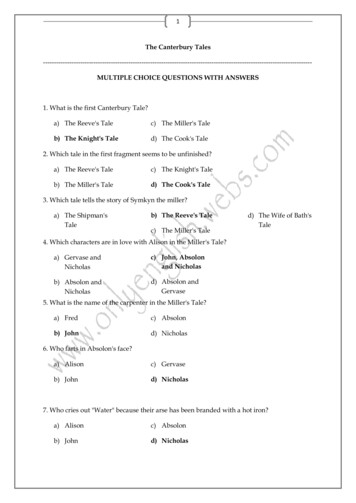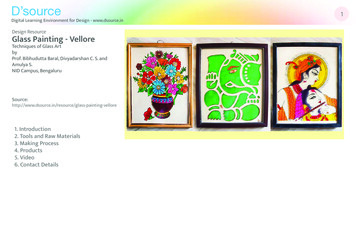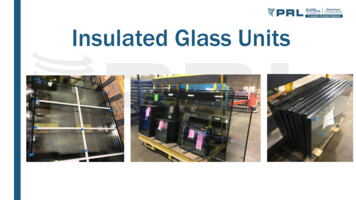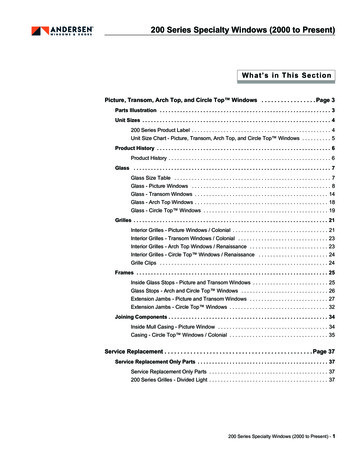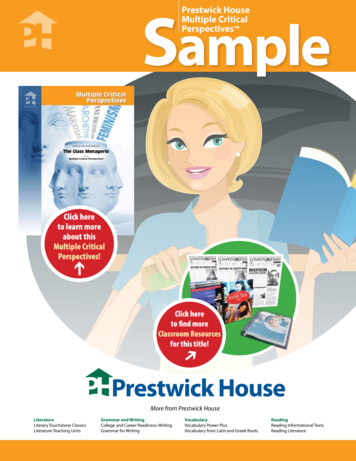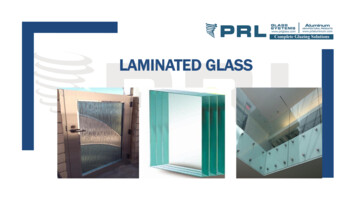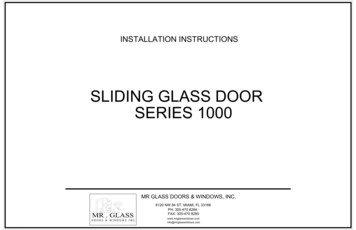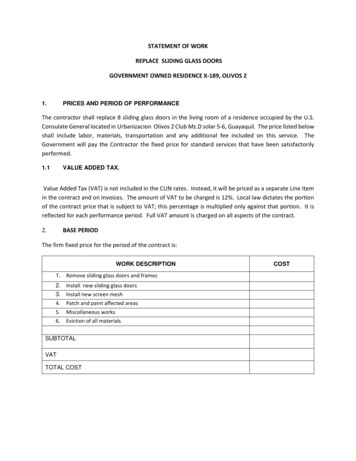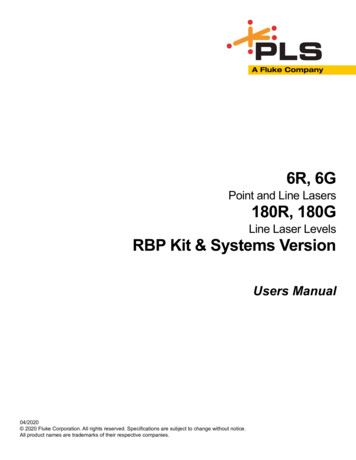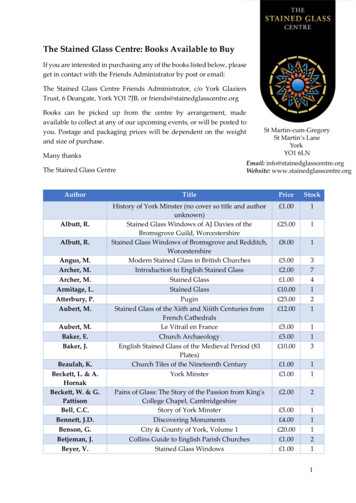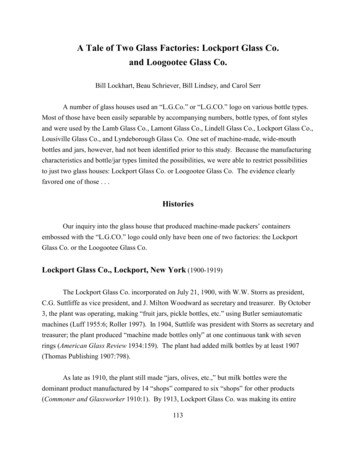
Transcription
A Tale of Two Glass Factories: Lockport Glass Co.and Loogootee Glass Co.Bill Lockhart, Beau Schriever, Bill Lindsey, and Carol SerrA number of glass houses used an “L.G.Co.” or “L.G.CO.” logo on various bottle types.Most of those have been easily separable by accompanying numbers, bottle types, of font stylesand were used by the Lamb Glass Co., Lamont Glass Co., Lindell Glass Co., Lockport Glass Co.,Lousiville Glass Co., and Lyndeborough Glass Co. One set of machine-made, wide-mouthbottles and jars, however, had not been identified prior to this study. Because the manufacturingcharacteristics and bottle/jar types limited the possibilities, we were able to restrict possibilitiesto just two glass houses: Lockport Glass Co. or Loogootee Glass Co. The evidence clearlyfavored one of those . . .HistoriesOur inquiry into the glass house that produced machine-made packers’ containersembossed with the “L.G.CO.” logo could only have been one of two factories: the LockportGlass Co. or the Loogootee Glass Co.Lockport Glass Co., Lockport, New York (1900-1919)The Lockport Glass Co. incorporated on July 21, 1900, with W.W. Storrs as president,C.G. Suttliffe as vice president, and J. Milton Woodward as secretary and treasurer. By October3, the plant was operating, making “fruit jars, pickle bottles, etc.” using Butler semiautomaticmachines (Luff 1955:6; Roller 1997). In 1904, Suttlife was president with Storrs as secretary andtreasurer; the plant produced “machine made bottles only” at one continuous tank with sevenrings (American Glass Review 1934:159). The plant had added milk bottles by at least 1907(Thomas Publishing 1907:798).As late as 1910, the plant still made “jars, olives, etc.,” but milk bottles were thedominant product manufactured by 14 “shops” compared to six “shops” for other products(Commoner and Glassworker 1910:1). By 1913, Lockport Glass Co. was making its entire113
output (all milk bottles) by semiautomatic machine in one continuous tank with 10 rings (Journalof Industrial and Engineering Chemistry 1913:953). The Thatcher Glass Mfg. Co. bought theLockport operation on October 17, 1919 and installed three Owens machines (see the secton onthe Thatcher Mfg. Co. for more on the plant from 1919 to 1942.). Because of the increasingpopularity of paper milk cartons during the 1930s and 1940s, Thatcher began experimenting atLockport with jelly, pickle, and coffee jars in 1942. The experiments were not successful, andthe plant shut down on June 6, 1942 (Dunn 1971:7; Luff 1955:7-8).Ayres et al. (1980:22-23) noted that a second “facility” was operated in New York Cityfrom 1906 to 1918 or 1919 (although we believe that may have been a sales outlet). Roller(1983:194), along with Luff (1955:7) and Dunn (1971:7) claimed that plant converted to themanufacture of milk bottles when Thatcher bought the firm in 1919; however, the 1913 articlecited above clearly stated that milk bottles were exclusively produced in the plant at that time –probably the reason Thatcher acquired the plant (along with several other competitors at the sametime).In March 1917, Lockport commissioned the H.L. Dixon Co. to build a 60-ton continuoustank and arranged for the installation of Hartford-Fairmont machines to produce milk bottlescompletely automatically from the blowing machines to the end of the lehr (National GlassBudget 1917:1). A 1918 article describing the installation noted: “Starting with the originalintention of making fruit jars, [Lockport] soon realized the big field ahead of them for glass milkbottles and immediately set out to reorganize their factory for the manufacturing of thiscommodity immediately” (Milk Dealer 1918:63). Oates (2004:6) showed the authors an undatedbooklet which clearly indicates that Lockport Glass Co. made milk bottles. According toThatcher v. Federal Trade Commission (U.S. Supreme Court), Lockport Glass Co. was dissolvedon October 20, 1920.Loogootee Glass Co., Loogootee, Indiana (1901-1904)John G. Clark, David F. Allen, Joseph P. Gray, and William R. Hines incorporated theLoogootee Glass Co., Loogootee, Indiana, on December 7, 1901, with a capital of 18,000. OnApril 7, 1902, Loogootee signed an agreement for 4,600 with William Butler to purchase three114
of the Butler semiautomatic bottle machines.1 The plant was in production by late June as a nonunion shop making fruit jars. The firm manufactured fruit jars until it sold to the Ball Brothers in1904. Clark was the president of the operation, with Gray as vice president, Allen as treasurer,and Hines as secretary (Roller 1994:56-57; 1998).By 1904, the plant made fruit jars at a single continuous tank with six rings. A letterhead,dated April 25, 1904, illustrated a Mason jar embossed “MASONS PATENT”; another fromSeptember 21 of that year claimed the factory as manufacturers of “Exclusively Machine MadeMason Fruit Jars.” The Ball Brothers purchased the operation on November 10, 1904, for 42,500 (American Glass Review 1934:153; Roller 1994:56-57; 1998). Like the Thatcher Mfg.Co., noted above, the Ball Brothers acquired quite a few of their smaller competitors.Creswick (1987a:160) called the company the Loogootee Fruit Jar Co. and dated it “to1904.” Midwest Antique Fruit Jar & Bottle Club (2005) added that the Ball Brothers closed theplant in 1906. Ball had a history of buying, then closing, plants. Walter Feagon purchased theplant and land for 650 in July of 1907 (Roller 1998).Containers and MarksThere is no question that the milk bottles embossed “L.G.CO.” – especially those with thelogo above the numeral “1” – were made by the Lockport Glass Co. (as explained below). Nor isthere any question that the Mason jars with the Lockport name were made at that location.However, the manufacturer of the machine-made packers’ jars and wide-mouth bottles – alsoembossed “L.G.CO.” – is not so firmly established.L.G.CO. / 1Oats (2004:6) positively identified the Lockport Glass Co. as the user of the “L.G.CO. /1” mark on milk bottles. He was also kind enough to send us a photocopy of a Lockport bookletthat illustrated a milk bottle embossed “L.G.CO . / 1” at the front heel on both the front and backcovers (Figure 1). The mark was occasionally found without the “1,” although these bottles are1Our searches have failed to discover a patent for Butler machines.115
more unusual. Elsewhere, we have discussed the milkcompany numbering system (e.g., Lockhart et al.2017). The bottles without the “1” were likely madeprior to the implementation of the numbering system,originated by the State of New York in 1910 and soonadopted as an unofficial national arrangement.Figure 1 – L.G.CO. / 1The Lamb Glass Co. also used the L.G.Co.mark, although it was always followed by “52” (L.G.Co.52), the number assigned to Lamb. Seethe section on the Lamb Glass Co. for more information.L in the Massachusetts seal[This section was originally published in Lockhart et al. 2017]From 1910 to 1947, the Commonwealth of Massachusetts required that all glass factoriesselling bottles to dairies within the state mark their containers with a Massachusetts seal. By atleast 1914, most factories embossed the seal on the shoulder of each milk bottle, usually in acircular form embossed “MASS (arch) / {factory designator} / “SEAL (inverted arch).” Theseoften appeared in a small plate mold (Blodget 2006:8; Schadlich [ca. 1990]).According to Schadlich (ca. 1990), the Lockport Glass Co. embossed the Massachusetts“L” seal on the shoulders of milk bottles from 1909 to 1919. The company’s typical heel mark(LGCO / 1) accompanied most (if not all) seals. Lockport used at least three configurations forthe seal (each accompanied by the typical manufacturer’s mark on the heel):1. The earliest was in an arched shape on the shoulder,with the “L” centered below the arch. These were almostcertainly used during the ca. 1909-1914 period, and theonly examples we have seen are on tin-top bottles(Figure 2).Figure 2 – Mass Seal L (eBay)2. The second type may have only been used on theapple-shaped Deerfoot cream jars. This one was “MASS SEAL L” in an arch on the reverse of116
the jar. The “L” was in the same line as the “MASS SEAL” inthis configuration (Blodget, personal communication 1/24/2008).This style was likely used during the 1912-1916 period.3. The final type was in the typical circular configurationdescribe above, with the “L” in the center of the circle (FigureFigure 3 – Mass L Seal (eBay)3). This seal was used during the ca. 1914-1919 period. Morin(personal communication 4/20/2007) noted that all three formats are equally common, and somehave the LGCO mark embossed on the base.The Lamb Glass Co. acquired the “L” seal in 1939. By that time, of course, the seal onlyappeared in the circular format (see section on Lamb Glass Co. for details). Thus, any archedseal may safely be attributed to Lockport. Since neither Lockport nor Lamb used date codes, theonly way to determine the user of the circular Massachusetts seal is to find another way torelatively date the bottle.MAINE LGCo 01 SEALIn 1913, Maine enacted a seal law similar to the one inMassachusetts. According to the Dairy Antique Site (2016),Maine awarded the Lockport Glass Co. Seal No. LGCo 01, almostcertainly to match the firm’s No. 1 that it used in most states(Figure 4). The Thatcher Mfg. Co. apparently applied for aFigure 4 – Maine LGCo 01 Sealnumber earlier than Lockport, receiving No. 1.LOCKPORT MASON and MASON IMPROVED (ca. 1900-ca. 1913)Toulouse (1969:186-187), Roller (1983:194) and Creswick (1987a:83) all described twomachine-made, shoulder-seal jars, embossed respectively “LOCKPORT MASON” and“LOCKPORT MASON IMPROVED” as made by the Lockport Glass Co. (Figure 5). Toulousedated the Lockport Mason ca. 1900-1920 and the Lockport Mason Improved at ca. 1915-1930.Roller placed both jars ca. 1900-1910s, but Creswick extended the period to 1920. It is prettycertain, however, that Lockport ceased jar production by no later than 1913.117
The Roller update(2011:296) added that onetype of Lockport MasonImproved had “an oddfeature on the upper finisharea. It is a helix on eachside of the mold seams inthe finish above the screwthread.” Leybourne(2014:243) added anFigure 5 – Lockport Masons (NorthAmerican Glass)interesting variation with areversed “LOCKPORTFigure 6 – Lockport Masons(Leybourne 2014:243)MASON” ghosted under thename in the correct aspect (Figure 6).L.G.CO. on Machine-Made JarsSeveral types of jars have been found with LGCo logos embossed on bases or bodies.These can be divided by jar types and manufacturing techniques into grooved-ring wax sealers,Mason jars (with LGCo monograms), and machine-made packer or product jars. All of theseshow characteristics of press-and-blow machines.Press-and-Blow Machine Jars and Wide-Mouth BottlesWe have discovered six examples of packers’ jars and wide-mouth bottles – eachembossed on the base with “L.G.CO.” – that were made by press-and-blow machines: three fromeBay, one sent to us by Jean Nargiz, one from David Whitten, and another illustrated byCreswick (1987a:101; 1987b:81). Since Creswick included the same jar in both volumes, shemust have felt that they were made during the ca. 1900-1920 period (Figure 7). Creswicksuggested the Loogootee Glass Co. as the maker of the jars.Each base was embossed “L.G.CO.” with one or more dots above the logo and a threedigit number below it (occasionally above). Dots in the sample include three dots in a line, three118
dots in a triangular pattern,and a single dot. Numbersincluded 52, 200, 210, and510 – probably modelnumbers – and eachnumber corresponded to ajar of a distinct differentstyle. All had slightly off-Figure 8 – L.G.CO. (David Whitten)center valve scars. TheFigure 7 – L.G.CO. Creswick(1987:81)color and style of lids indicated thesame general dates as the Creswickrange. These appear to be commonand must have been made in large quantities. Leybourne(2014:236), for example, priced the fruit-jar shaped ones at 1-2each.Probably the oldest jar in thesample was short, sun-colored amethyst incolor, with a squared-ring finish. TheFigure 9 – Short jar (DavidWhitten)basal manufacturer’s mark was “L.G.CO.”in a slight inverted arch below a faint “52” (nota date code). The “G” appeared to be a “C”with a serif added by hand. The “L.G.CO.”was much smaller than we have seen on anyother container (Figures 8 & 9).Another, also amethyst in color,resembled a pint Mason jar. Both exampleswere embossed on the bases with “L.G.CO. /200” – but one had three dots above the logo,Figure 10 – Product jar(eBay)the other only one (Figure 10). A wide-mouthbottle was oval in cross-section with acontinuous-thread finish. The base wasembossed “L.G.CO. / 510” with three dots above the logo (Figure 11).119Figure 11 – Oval bottle(eBay)
The final example in our sample was colorless, decagonal in cross-section with rounded bands atshoulder and heel – with a continuous-thread finish. The base was embossed “L.G.CO. / 135.”The basal embossing was faint, so we could not detect the presence of dots above. The Creswickjars were identical to quart shoulder-seal Masons, embossed “L.G.CO. / 210” on the base withthree dots in a triangular shape above the logo.Discussion and ConclusionsIn our attempt to be thorough in our search for the user of the “L.G.CO.” logo on thebases of product (packers’) jars, we have searched through every source we could find for firmswith the L.G.Co. initials, looking for a glass house that was in business between 1896 and 1920,the likely production period for jars bearing the logo, and known to have used press-and-blowmachines during the time. Most notably, one of the authors spent days searching through theDick Roller files, one town at a time, seeking a plant with the initials. Our list of probablecandidates narrowed down to two: The Lockport Glass Co. and the Loogootee Glass Co.Both Loogootee and Lockport were open during the early years of the 20th century, andboth made jars on press-and-blow machines. While Loogootee made jars – including fruit jars –we have found no evidence for product jars from the company. From 1900 to at least 1910,possibly as late as 1913, however, Lockport produced “pickle bottles”as well as “jars, olives,etc.” before switching to milk bottles by 1913. In addition, Lockport certainly used the “L.G.CO./ 1” mark on its milk bottles.This trend toward machine-made jars and wide-mouth bottlesfor at least the first decade of the 20th century, combined with the use ofa capital “O” in “CO” on both milk and packers’ jars, strongly suggeststhat Lockport was the user of the logo in both cases. While certainlynot diagnostic by itself, the basal scars from the “L.G.CO” product jarsand “LOCKPORT” Mason jars were very similar (Figure 12). Whilethe Loogootee Glass Co. cannot be totally ruled out, we have found noevidence that the firm ever used any type of identifying mark. Allavailable evidence supports the Lockport Glass Co. as the user of the“L.G.CO.” logo on all machine-made, wide-mouth bottles and jars. It120Figure 12 – LockportMason (top); product jar
appears that Lockport used Mason jars embossed with the Lockport name as its fruit jars andidentical (or similar) jars without the side embossing – but “L.G.CO.” on the base – as itsprimary packer line.AcknowledgmentsWe would like to thank Doug Leybourne for allowing us to reproduce the drawings fromthe Alice Creswick books and Greg Spurgeon for granting us permission to use the photos fromNorth American Glass. Gratitude also to Wanda Wakkinen for tireless proofreading.SourcesAmerican Glass Review1934 “Glass Factory Yearbook and Directory.” American Glass Review, Pittsburgh,Pennsylvania. Includes reprint of the Glass Trade Directory for 1904. CommonerPublishing Co., Pittsburgh, Pennsylvania.Ayres, James E., William Liesenbien, Lee Fratt, and Linda Eure1980 “Beer Bottles from the Tucson Urban Renewal Project, Tucson, AZ.” Unpublishedmanuscript, Arizona State Museum Archives, RG5, Sg3, Series 2, Subseries 1, Folder220.Blodget, Bradford G.2006 “Milk Bottles from the Heart of the Commonwealth: A Collector’s Guide to theMilk Bottles from the City of Worcester, Massachussetts, 1890-2006.” Unpublishedmanuscript.Commoner and Glassworker1910 “Pith of the Week’s News: All the News of the Glass Trade Compiled inCondensed Form for Quick Reading.” Commoner and Glassworker 28(18):1.121
Creswick, Alice1987a The Fruit Jar Works, Vol. I, Listing Jars Made Circa 1820 to 1920's. Douglas M.Leybourne, N. Muskegon, Michigan.1987b The Fruit Jar Works, Volume II, Listing Jars Made Circa 1900 to Modern.Privately printed, Grand Rapids, Michigan.Dairy Antique Site2016 “Doug & Linda's Dairy Antique Site: Milk Bottle Manufacturers.”http://dairyantiques.com/Milk Bottle Makers.htmlDunn, Jean W.1971 Glass: Lancaster and Lockport, New York. Vol. XVII. Buffalo and Erie CountyHistorical Society, Buffalo, New York.Journal of Industrial and Engineering Chemistry1913 “The Present Status of the Glass Bottle and Hollow Ware Industries in the UnitedStates.” Journal of Industrial and Engineering Chemistry 5(11):951954.Leybourne, Douglas M.2014 The Collector’s Guide to Old Fruit Jars: Red Book 11. Privately published, NorthMuskegon, Michigan.Lockhart, Bill, Pete Schulz, and Al Morin2017 Milk Bottle Seals: The Other Manufacturer’s Marks. Historic Glass BottleIdentification & Information Website: References. https://sha.org/bottle/References.htmLuff, Howard S.1955 “History of Glass in Lockport.” Unpublished manuscript (apparently a college classpaper for English 101). Copy on file with Niagara County Historical Society, Lockport,New York.Midwest Antique Fruit Jar & Bottle Club2005 “Glass Plant Purchases.” htm122
Milk Dealer1918 “Evolution in Making Milk Bottles.” Milk Dealer 7(6):63.National Glass Budget1917 “Lockport Capacity to Be Doubled.” National Glass Budget 32(44):1. [March 10]Oates, Paul2004 “Positive Identification Established for Lockport Glass Mark.” The Milk Route288:6.Roller, Dick1983 Standard Fruit Jar Reference. Acorn Press, Paris, Illinois.1994 Indiana Glass Factories Notes. Acorn Press, Paris, Illinois.1997 “Lockport, NY Historical Notes.” Dick Roller files.1998 “Loogootee, IN History Notes.” Dick Roller files.Schadlich, Louisca. 1990 “Milk Bottles Marked by Manufacturers and Jobbers.” Unpublished manuscript.Thomas Register of American Manufacturers1907-1908 Thomas’ Register of American Manufacturers and First Hands in all Lines:The Buyers Guide. Thomas Publishing Co., New York.Toulouse, Julian Harrison1969 Fruit Jars. Thomas Nelson & Sons, Camden, New Jersey.United States Supreme Court2004 [1926] Thatcher v. Federal Trade Commission, 272 U.S. 554 (1926), No. 213.http://caselaw.lp.findlaw.com/scripts/printer friendly.pl?page us/272/554.htmlLast updated 5/13/2017123
124
"LOCKPORT MASON IMPROVED" as made by the Lockport Glass Co. (Figure 5). Toulouse dated the Lockport Mason ca. 1900-1920 and the Lockport Mason Improved at ca. 1915-1930. Roller placed both jars ca. 1900-1910s, but Creswick extended the period to 1920. It is pretty certain, however, that Lockport ceased jar production by no later than 1913. 117

